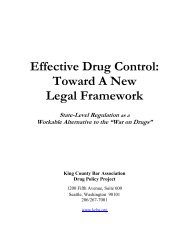RACE AND THE ENFORCEMENT OF DRUG DELIVERY LAWS IN ...
RACE AND THE ENFORCEMENT OF DRUG DELIVERY LAWS IN ...
RACE AND THE ENFORCEMENT OF DRUG DELIVERY LAWS IN ...
You also want an ePaper? Increase the reach of your titles
YUMPU automatically turns print PDFs into web optimized ePapers that Google loves.
HYPO<strong>THE</strong>SIS 4B: <strong>THE</strong> FOCUS ON CRACK COCA<strong>IN</strong>E REFLECTS RESIDENT COMPLA<strong>IN</strong>TS ABOUT<br />
NARCOTICS ACTIVITY<br />
When asked to explain drug law enforcement patterns in Seattle, police and city<br />
officials have suggested that SPD deployment decisions are driven primarily by<br />
public complaints. 124 Civilians may register complaints regarding drug activity in<br />
two ways. First, a civilian complaint regarding narcotics activity is sometimes<br />
recorded by SPD personnel as a “Narcotics Activity Report” (NAR).<br />
Alternatively, civilians may call 9-1-1 to report perceived and ongoing drug<br />
activity. In the previous analysis of civilian complaints about drug activity, 125<br />
only NARs were made available by the Seattle Police Department for analysis.<br />
For the 2005–2006 time period, however, both NARs and civilian 9-1-1 calls<br />
initially coded as narcotics-related by the 9-1-1 dispatcher received in April and<br />
May 2005 and May 2006 were made available for analysis.<br />
It is important to note at the outset that civilian reports of drug activity may or<br />
not be accurate. Indeed, civilian complaints registered via 9-1-1 calls were not<br />
infrequently determined by police officers to have been incorrect and/or<br />
unreliable. For example, some 9-1-1 callers reported what they perceived to be a<br />
large group of black teenagers smoking crack cocaine; when the police arrived,<br />
they found instead a few youths, some of whom were smoking cigarettes (see<br />
Appendix B for this and other examples of unreliable civilian reports of drug<br />
activity). 126 Because officers are often unable to locate suspects upon arrival, and<br />
because this failure to locate suspects may or may not mean that the call was<br />
unreliable, it is not possible to determine the relative frequency of accurate and<br />
inaccurate reports. 127 Nonetheless, it is noteworthy that officers responding to 9-<br />
1-1 calls about perceived narcotics activity typically responded in a timely<br />
fashion: the average (mean) number of minutes lapsed between the time the call<br />
was received by 9-1-1 dispatchers and the time officers arrived on the scene was<br />
less than 26; officers arrived at the scene within 15 minutes half of the time. Still,<br />
124 See Klement and Siggins 2001: 26; Deposition of Robert Scales in State of Washington v.<br />
Richard Nelson, March 12, 2008, at p. 185; on file with author.<br />
125<br />
Beckett 2004.<br />
126 An emerging body of research suggests that racial stereotypes shape perceptions of the<br />
seriousness and/or dangerousness of potentially crime-related situations, particularly when<br />
information about those situations is limited (Quillian and Pager 2001; Sampson and<br />
Raudenbush 2004).<br />
127 Although officers may enter a disposition code that signifies the determination that the call<br />
was unfounded, officers do not always clear the call with this code even when they indicate in<br />
their response to dispatcher that the call was unreliable, unfounded or “bogus.” It is therefore<br />
not possible to count the number of unfounded or false complaints.<br />
84

















